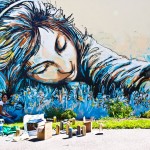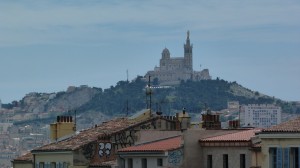“What does travel ultimately produce if it is not, by a sort of reversal, ‘an exploration of the deserted places of my memory’, the return to nearby exoticism by way of detour through distant places, and the ‘discovery’ of relics and legends […]”
Michel de Certeau
 If we have become a bit too familiar with the urban environment, it can happen everyday that we pass by, but hardly notice a particularly richly ornamented door, get a glimpse of a flash of colour as a window catches the last rays of the setting sun, or even walk past something as plain as a few, curiously orderly arrows painted in fading white. It happens many times during the daily commute after it has become a mindless, automatised routine, that we notice things only when others’ obvious interest catches our eye.
If we have become a bit too familiar with the urban environment, it can happen everyday that we pass by, but hardly notice a particularly richly ornamented door, get a glimpse of a flash of colour as a window catches the last rays of the setting sun, or even walk past something as plain as a few, curiously orderly arrows painted in fading white. It happens many times during the daily commute after it has become a mindless, automatised routine, that we notice things only when others’ obvious interest catches our eye.
The urban skin, by László Munteán’s definition, is the uppermost layer of the façade of all the buildings in a city. If the wall is a skin, then, continuing the metaphor applied by Munteán, all the signs, plaques, busts, statues, bullet marks and graffities may be seen as marks, scars, or tattoos on the living, breathing, and constantly growing body of the city. Some of these are integrated into a system of references that are generally understandable to the average passer-by, such as street signs and memorial plaques, but others are relics of times past, such as the white arrows Munteán’s essay, “Under the urban skin” deals with. In a 21st century urban landscape, these arrows seem out of context; they have no immediately identifiable function, and their aesthetic value is debatable at most, especially since they are found almost exclusively on the façades of buildings that are more than usually run down.
the buildings in a city. If the wall is a skin, then, continuing the metaphor applied by Munteán, all the signs, plaques, busts, statues, bullet marks and graffities may be seen as marks, scars, or tattoos on the living, breathing, and constantly growing body of the city. Some of these are integrated into a system of references that are generally understandable to the average passer-by, such as street signs and memorial plaques, but others are relics of times past, such as the white arrows Munteán’s essay, “Under the urban skin” deals with. In a 21st century urban landscape, these arrows seem out of context; they have no immediately identifiable function, and their aesthetic value is debatable at most, especially since they are found almost exclusively on the façades of buildings that are more than usually run down.
Without first-hand experience of the arrows’ significance, all there is to do is to rely on other people’s memories. Their remembrances, when passed on to us through photographs, stories, or other media become our imagined memories. However, Andreas Huyssen argues that all memories are inherently imagined; memory being an intangible concept, it is irrelevant whether we remember what happened to us, or remember a memory that was shared with us. So it seems all memories are unreal, as they are subjective representations of an experience, with a certain focus and a perspective – in that they are like mental photographs. Roland Barthes uses the word studium to describe a general interest in a photograph. That inexplicable quality, which points to something beyond the surface, he named punctum; it is actually something that is not on the photograph, and what causes the observer’s desire to discover what is beyond.
During the exploration of the multi-layered urban skin or the “deserted places” of our memory, we, the observers, become travellers. The unconventional journey teaches us, the local tourists, to appreciate what Michel de Certeau calls “nearby exoticism”.
About Urbex: Barczi Tamás: What is Urban exploration? , Barczi Tamás: Stalker: Budapest Edition
1. http://www.collater.al 2. http://wallpaperskat.com/



